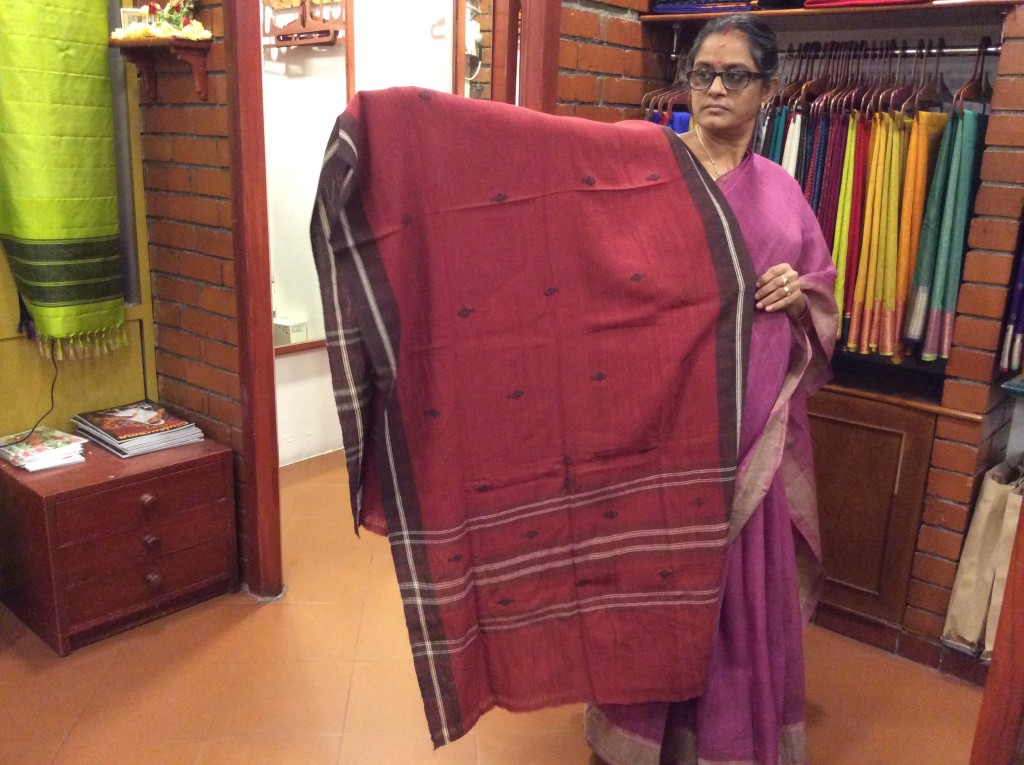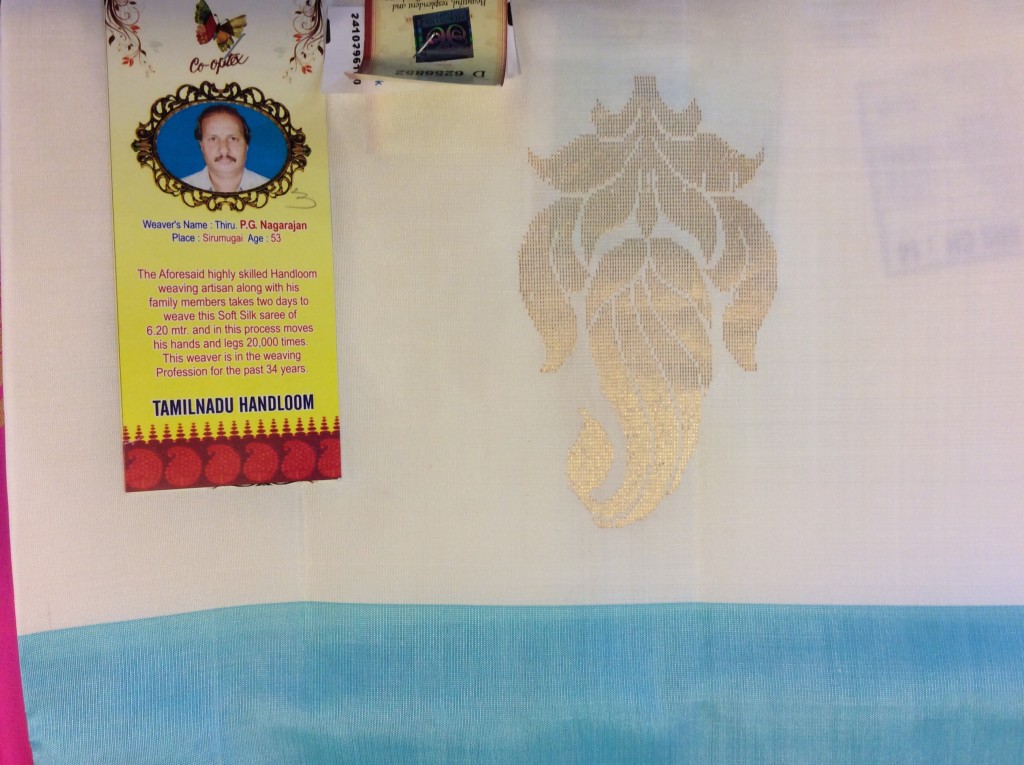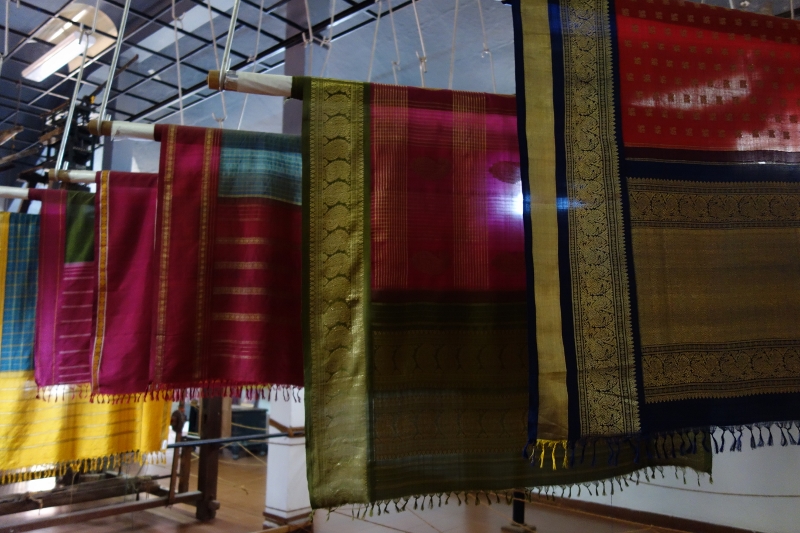This post is part of a series on textile travels in the South of India, others include Hyderabad and Sircilla in Andhra Pradesh.
Chennai has a lot to offer for the art, craft or textile lover. It is home to the Crafts Council of India that supports crafts through exhibitions, education, marketing and more. The Kalakshetra cultural foundation promotes the study of the performing and visual arts. It was founded by Rukmini Devi Arundale – ‘the Institution stands testimony to her dream of creating a space where the essence of Indian thought would find expression through artistic education,’ and standing in defiance with ‘vulgarity and commercialism’. Notably, as I later write about my visit to Kanchipuram, Rukmini Devi was a strong patron of Kanchipuram weaving and developed her own ‘kalakshetra saris’. The weaving unit continues to run, but as Gita Ram of the Crafts Council showed me round, she said they have struggled to bring in more weavers and a few looms were stood empty. A common story of many weaving centres across the south, especially where there is labour intensive work involved that is now becoming replaced by faster modes not achieving the same quality.

Along the road between Chennai and Pondicherry lies more recently opened cultural museum, Dakshinachitra. Set within a large open village-like space, art, architecture, lifestyles, crafts and performing arts of South India are showcased. Its a lovely oasis, set back from the main highway near the sea and well-shaded by lots of trees. Footpaths lead you to various traditional vernacular buildings of each state in the south. Stepping inside you see an authentic interior and the crafts and textiles that would have been produced in that house are displayed. There is also a large museum, art galleries, library, restaurant and shop, as well as craft stalls lining the paths. Its a fun, interactive and educational celebration of the south’s cultural heritage.


On my first day in the city, I had a wander round leafy south Chennai, first visiting the Crafts Council of India, then onto CP Ramaswamy road, a hotspot for high-end fashion and sari boutiques. One of these is Shilpi selling handloom textile products from craft communities across India, founded in 1980 by Arundhati Menon and Bhamini Narayanan. I was lucky to meet Bhamini, who told me her inspiration for founding the store was the handloom she was surrounded by growing up, which her mother would always buy and wear. Bhamini has now retired and has sold Shilpi, but she is still an active presence in the Handloom world.
Bhamini kindly invited me to her apartment beautifully decorated, of course with lots of hand-crafted Indian textiles and products. She exuded style and grace in her stunning sari (handloom of course). We chatted about the current situation of handloom. ‘The situation is bad now, there were many more weavers when I started Shilpi back in the early 1980’s,’ Bhamini lamented. She worried that soon there will only be mass-produced polyester saris. One point she made was that while development organisations have made a positive impact on weavers, particularly in releasing them from ties with exploitative master weavers, some weavers have become overly money focused, realising there is an increasing monetary value in high-end markets for their woven products. But this realisation of the popularity of handloom in high-end markets is not necessarily enough to encourage young people to enter handloom as an occupation, Bhamini thinks.
Bhamini went on to talk about the importance of a sense of community for handloom weavers. Now that communities are dispersing with many individuals or families migrating to cities, there isn’t the same support that there used to be. Further, if parents know that their child can earn more in a city office job than as a weaver, why would they discourage that?

Shilpi is now being co-managed by Simrat Chadha, whom I met at the Shilpi shop on CP Ramaswamy rd in Alwarpet (there are 3 stores in Chennai, one in Alwarpet, one in Besant Nagar and one in Nungambakkm). Simrat, like Bhamini was very open and friendly and happy to talk about the work of Shilpi. It was nearing Diwali and the shop was full of excited customers buying saris – one of the traditions of Diwali along with sharing gifts, sweets and meals with family and friends, and of course firework displays. There were some beautiful saris available sourced from across India, including Kanchipuram, Mysore, Andhra Ikat, some kalamkari painted silk with a block printed border, bandhani and more. Shilpi has played with unique combinations of traditional techniques. But mostly design is left to the artisans themselves. The shop also had a wide range of cut garments, fabric lengths, jewellery, stoles and dupattas. I couldn’t resist a handloom kurta dyed in al root from a tribal community in Madhya Pradesh.
The saris from Kanchipuram, my next destination, were selling well. Visitors come to Kanchipuram from all over to shop for saris, particularly bridal saris, or to visit the many historic temples. I went to meet Sasikala, the design director at the government Weavers’ Service Centre. The 28 Weavers’ Service Centres across India are an initiative of the Development Commissioner (Handlooms), and provide technical and design assistance to the weavers in the region they work.


Another government initiative to support handloom at state level is the cooperative societies, which originally started in the early 20th century with an aim to release weavers from the ties of exploitative master weavers. The Tamil Nadu state apex cooperative society is Cooptex which acts as an umbrella for many societies across the state. Society initiatives include advancing yarn and supplies and marketing the products. The impact of these initiatives has varied from society to society. Sasikala took me to one society outlet on the main street in Kanchipuram which is lined with hundreds of sari stores, some run by the societies, others private. One initiative by the society we visited was to attach the name, details and a picture of the weaver to the sari, along with the handloom mark, and a silk mark, to:
a) prove its authenticity to the customer – real silk and made using the techniques and materials considered unique to Kanchipuram saris (korvai, patni and real zari). These are the criteria set out by its Geographical Indication– a mark of intellectual property that prevents imitation by powerlooms or producers outside its original place of production (which in itself has initiated wide debate – see Aarti Kawlra’s work)
b) avoid the exploitative practice of master weavers or traders posing as the weaver and rendering the actual weaver anonymous and out of reach of his rightful remuneration. Sasikala informed me that often master weavers will submit a piece woven by one of his wage weavers, for the National Award (a government craft development scheme to recognise individual master artisans), passing it off as his own. It seems that this practice is common in other scenarios too – the running of exhibition stands at the successful Dastkaari Haat Samiti exhibitions are currently being overrun with master weavers and traders, where the aim of these fairs is to connect the individual artisans directly with their clients.


We also visited a (genuine) National Award winning weaver Shri B Krishnamoorthy who is one of just a few weavers still practicing the traditional techniques of Kanchipuram saris, such as the korvai and patni techniques. The korvai technique involves the use of 3 shuttles, one for the body, and one for each border. This enables completely separate warp and weft colours to be used. Having a contrasting body and border colour with the pallu colour matching the border colours is the main characteristic of a Kanchi sari. The patni is the interlocking technique for the pallu. These techniques are similar to other interlocking techniques used in sari weaving in the south, as I mentioned in my previous post.



In the past these techniques were possible because of the reliance on cheap labour, often provided my children who would eventually become highly skilled. Now organisations are making positive efforts to eradicate child labour (rightly so of course). But the debate around preserving treasured, time-honoured skills and processes, while providing sustainable, desirable livelihoods continues. It seems to me these saris continue to be popular though, so as long as they can be positioned well in a ready market, weavers receive their rightful remuneration and design is carefully considered, I’m sure Kanchipuram weaving will continue to thrive…
Next post will cover the rest of my journey in Tamil Nadu and visits to the historical and important, but struggling weaving centres Erode and Salem.



One Comment
clara
very nice read…. I loved every bit of your article. It made me nostalgic. These weavers do not get recognised for their work. I ended up reading your article while I was searching for the best place to buy curtain fabric in chennai